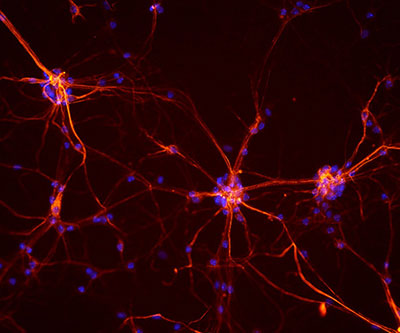
Healthy mouse spinal cord neurons
Credit: NICHD
Amyotrophic lateral sclerosis (ALS) is a fatal neurodegenerative disease characterized by the gradual deterioration and death of motor neurons, the nerve cells responsible for controlling voluntary muscle movement. Currently, there are very few treatment options for ALS, and those that are available have limited efficacy.
Previously, the Le Pichon Lab found that motor neuron degeneration in a mouse model of ALS can be delayed by deleting the protein dual leucine zipper kinase (DLK), which senses damage to the axon—the part of the nerve cell that enables it to communicate with other neurons. However, DLK is also involved in axon regeneration, prompting the scientists to consider whether combining DLK deletion with a way to promote axon regeneration would result in greater motor neuron protection.
The researchers evaluated a combinatorial approach in their mouse model by genetically deleting DLK and boosting the production of ATF3, a regulator of neuron regeneration. The combination more powerfully preserved motor neuron connectivity to muscle than either approach alone. In mice with both genetic changes, fewer motor neurons died, axon degeneration was reduced, and motor function was preserved. Although the combination did not extend the lifespan of the mice, the findings suggest the potential to improve quality of life during the symptomatic phase of ALS.
The researchers note that their approach could be translated into a potential ALS treatment by developing medications that block DLK and providing ATF3 through gene therapy. The work highlights the importance of combining multiple therapeutic strategies to effectively treat a complex neurodegenerative disease like ALS.
Learn more about the Molecular Medicine Group: https://www.nichd.nih.gov/about/org/dir/affinity-groups/MM
 BACK TO TOP
BACK TO TOP